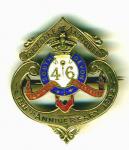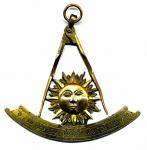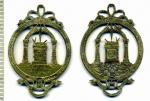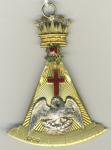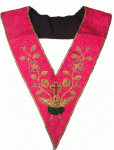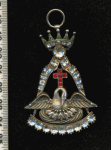
wm5806
Past Contributor-
Posts
230 -
Joined
Content Type
Profiles
Forums
Blogs
Gallery
Events
Store
Everything posted by wm5806
-
Well done, Patterdale, don't know how I managed to forget that one! Although there is a lot of information in 'Serendipity', I have seldom managed to find references in there to jewels in which I am interested. It must have taken a lot of work to put together, but (IMHO) it is a long way from being comprehensive. Some of the older texts I find useful and to which I alluded in my original post: Poole, Rev. Herbert. 1939. A catalogue of Masonic Medals in the Museum of the Provincial Grand Lodge of Worcestershire. Library and Museum committee, Worcester. A detailed list of over 1,000 medals, jewels and tokens in the museum. A standard work which should be readily available to all collectors of Masonic medals. Well organised by country and then chronologically, but no index. Shackles, GL. 1901. The Medals (Commemorative or Historical) of British Freemasonry. Jointly published by: The Hamburgische Zirkel-Correspondenz (or Literary Committee of the Grand Lodge of Hamburg) and The Quatuor Coronati Lodge No. 2076, London. Probably the first British publication with 12 plates and 175 illustrations, but much of it is contained within Poole's book. Hammond, W. 1917. Masonic Emblems and Jewels: treasures at Freemasons' Hall, London. George Philip and Son Ltd., London.. Nice little book by WBro Dr W Hammond FSA, the Librarian at Grand Lodge, with 18 coloured plates and 42 B/W. Some real gems in there, but barely touches on the treasures that the vaults must have contained, even then. Marvin, WTR. 1880. The Medals of the Masonic Fraternity described and illustrated. Privately published by the author in Boston, USA, and limited to 160 copies. The definitive work for collectors of Masonic medals, to which a supplement was produced afterwards. Over 700 medals are described in great detail, many of them having Continental origins. Still by far the best and most comprehensive listing. Several indices, including by legend, subject depicted, issuing Lodge and engraver. Quite an overlap with Poole but, when conjoined (and with the supplement), they form the best listing. Lane, J. 1891. Centenary Warrants and Jewels. George Kenning, London. Wonderful tome by a very emminent Masonic scholar that sets out to record the 'pre-regulation' centenary jewels struck for Lodges whose centenary was celebrated prior to the introduction of the regulation-pattern centenary jewel, first seen in 1867. Although it claims to be exhaustive, there are one or two that are not included. Neither is this list exhaustive! There may be one or two of which I know but accidentally omitted, but I am sure that there are quite a few out there which I have yet to come across - please be generous and share them with me! Just a post-script: as these are all out of print, and probably were never produced in great numbers initially, do not expect them to be cheap! When the books are rarely available for sale, I have seen them in the following price ranges: Poole (scarce) ?40 - ?100 Shackles (rare) ?60+ Hammond (uncommon) ?15 - ?50 Marvin (very rare) ?1,000+ (with or without supplement) Lane (scarce) ?30 - ?100 Kind regards WM5806 Further post-script: where this post refer to 'medals', it generally means those coin-like commemorative pieces which were never meant to be worn, rather than personal 'jewels' which obviously may be worn. The term however, is taken to have different meanings by different authors.
-
46th Regiment of Foot - Masonic Lodge
wm5806 replied to wm5806's topic in Great Britain: Research, Documentation & History
Thank you Michael, I shall try to get hold of that text. However, if the Lodge of Antiquity was 150 years old in 1902, the implication is that it was warranted in 1752 and had been there for nearly 100 years before the foundation stone was laid. Curiouser and curiouser, as one little girl was heard to say Thanks for your help, WM5806 -
Greetings All, Although this is not my usual haunt in the GMIC, that being the Masonic section, there is some overlap in a post I made there yesterday. I have a Masonic badge (or jewel) from the Lodge of Antiquity in Montreal, celebrating it's 150th Anniversary in 1902. On the badge is the number 46 and the words "South Devon", "Sevastopol" and "Salamanca", which I assume to pertain to the 46th Regiment of Foot, being the South Devons and these are their battle honours. The post can be found HERE. My further assumption is that the Regimental Lodge settled in Montreal when they were posted there and remained behind when the Regiment left. I would be grateful if anyone can firm up those assumptions with their knowledge of the military aspect of this Lodge. My kindest regards, WM5806
-
Dear all Besides my interest in jewels, I am a certified bibliophile, resulting in my pathetically grabbing any books that I can that may help educate me about Masonic jewels. As most of you know, there are precious few books on the subject and the majority of those that exist are usually from before the last war (1939). Besides the Grand Lodge yearbooks which help me see when a Lodge started, where it met and sadly, when, if it was erased, there is also a free electronic version of Lane's Masonic Records on-line at the website of the University of Sheffield (Lane's Masonic Record); they also maintain a similar list for the Lodges of the Grand Lodge of Scotland (Draffen's Scottish Masonic Records 1736-1950). I have listed those books which I have found helpful and hope that you will tell me of any others I may have overlooked. (In no particular order) 1. Heathcote DJ. 1999. The Festivals 1900-1985 Stewards jewels of the Royal Masonic Institution for Boys. Meridian Publishing. ISBN 0952646412. Photographs all the Stewards jewels for this Institution, other data including numbers awarded, charitable sums raised, etc. Also include concise history of the RMIB. This is a companion volume to number 2, below. 2. Heathcote DJ. 1995. The Festivals 1900-1985 Stewards jewels of the Royal Masonic Institution for Girls. Meridian Publishing. ISBN 0952646404. Similar to number 1, but for the RMIG. 3. Jackman W. circa 2000. Masonic Memorabilia for Collectors. Gemini Publications Ltd. ISBN 0953063720. Many photographs of jewels, some of them very rare. I have issues about some of the text, especially the suggested pricing of many artefacts, but the book is worth having just for the photos of the rare jewels. 4. Dennis VS. 2005. Discovering friendly and Fraternal Societies: their badges and regalia. Shire Publications Ltd. ISBN 0747806284. Absolutely wonderful book that deals with many of the Friendly and Fraternal societies that existed around the end of the 19th Century, but by no means dealing exclusively with Freemasonry. Unparalleled photographs of many rare artefacts from the vaults of the Museum Of Freemasonry in London. Authoratively written, nice book to read and so many rare items pictured.... gorgeous! Was top of my list for Santa last year. I think that covers all of the more recent books, but I remain happy to be corrected by anyone who has a few that I may have missed. If of any interest, I will post a list of the older (and sadly, rarer) books to which I sometimes refer. Kind regards WM5806
-
And here's the second Masonic item with military associations: It's a jewel from the Lodge of Antiquity in Montreal, celebrating their 150th jubilee in 1902. Interestingly, it also has on it "46", "South Devon", "Dominica" and "Sevastopol". I assume this to be a reference to the 46th Regiment of Foot which were known as the South Devons, I believe. I also believe these to be their battle honours. Can anyone tell me if there was a lodge that travelled with the regiment that settled in Montreal? Does the Lodge still exist? Would be grateful for any information. Have looked in Lane's Miltary Lodges without any luck. Regards, WM5806 [attachmentid=22244]
-
Greetings to all the Masonic collectors and hopefully a few military collectors who may stray this way! Here's the first of two postings: A Founder's jewel for the New Zealand Expeditionary Force Masonic Association that has two bars stating "Founded in" and "France 1917". The jewel is made by Kenning and Son of London, from 18ct gold and appears to be dated 1923. There is also a name and number engraved on the back. Can anyone tell me anything about this Association, please? Yrs, WM5806 [attachmentid=22243]
-
Hi Mike As you have probably gathered, Freemasonry in England and Wales (Scotland and Ireland have their own arrangements) is organised quite differently to the US. Although the we are quite small in land mass, we are quite densely populated and our Grand Lodge is broken down into Provinces before you get to the individual, or Private, Lodges. As such, although I am in the Lodge of St Peter in Exeter (number 5806), it is part of the Provincial Grand Lodge of Devonshire which, in turn, is then part of the United Grand Lodge of England - united because we united the 'Antients' and 'Moderns' in 1813. Both our Provincial and Grand Lodge officers wear gold jewels, with many of the senior Provincial Officers holding Grand offices in their own right, all but two private Lodges wear jewels of silver. The only two exceptions to this are Lodge of Antiquity (number 2) and British Lodge (number 8), I think. I do not know the original reason for this - perhaps Kgard or one of the other senior members know? Regards WM5806
-
And another! This time in brass. No markings and fractionally larger than the last. Some evidence of repairs, but many, many years ago and performed quite crudely by rivetting a plate on the back - I reckon it adds to it's character! Similar sort of age, I imagine. YS&F WM5806 [attachmentid=22042]
-
Here's another for you enthusiasts: A Past Master's collar jewel from the days of the Antients. Silver, hallmarked 1812 with a maker's mark of I.R., measuring 105mm across by 95mm high (4.13" by 3.74" for those used to different units). Sadly not engraved. Am slowly running out of treasures to show you . Let's see some of the nice enamels other members must have! Yrs etc WM5806 [attachmentid=22041]
-
Sorry guys, Just one more to show you this week! Another Harper from 1824 in what I am told was the original design for the Royal Arch jewel, and is still used in Scotland. I was told that the difference is that one has "We have found" engraved on it and the other has "We have found it", but not so sure about that. [attachmentid=21802] Hope y'all have a great weekend and I look forward to seeing some of the other members' 'little treasures'! Sincerely yours, WM5806
-
Kgard You're absolutely correct - I have just checked my copy of KB Jackson's "Beyond the Craft" (for the benefit of others, a handy little publication that explains all the Masonic degrees as worked in England and Wales after Craft Masonry), which confirms your statement about Rose Croix being the only "Christian degree". However, Jackson also states that: - in order to be admitted to the Knights Templar/Malta degrees a candidate "must be of the Christian faith" and, consequently as membership of Knights Templar Priest and the Knights Beneficient of the Holy City are restricted to those in KT/M, then it follows that whilst they might not be Christian degrees, they only have Christian members (perverse logic, I know!) - only Christian Brethren are eligible for the Plymouth Working of the Allied Masonic degrees - Candidates for membership of the SRIA need to "fully embrace the priciples of Christianity" So, I think in the interests of harmony and FINALLY CLOSING this post, we can conclude that in England and Wales Rose Croix is the only Christian degree, but there are several others for which a professed Christian faith is a necessary qualification. I hope that's a fair summary <PHEW!> and let's get back to the medals and jewels!! WM5806
-
-
Gentlemen and Brethren, I have attached a picture of a jewel, highly prized among collectors, and reasonably rare. It is the pendant part of a Royal Arch Chapter member's jewel in silver-gilt and hallmarked for London in 1824, made by Thomas Harper. Harper was not only a skilled silversmith whose mark was registered in 1790, but also an important Mason, rising very quickly through some of Freemasonry's highest offices: Junior Grand Warden (1785), Joint Grand Secretary (1792-1795), Deputy Grand Secretary (1797-1800), Deputy Grand Master (1801-1813; Antients). I believe that he was also responsible for the design of this jewel, which continues on nearly 200 years later. It would appear that these jewels formed much of his output, although examples of many other jewels for different degrees are well documented. Thomas Harper is so highly respected amongst scholars of Masonic jewels that a research Lodge was formed and named after him, dedicated to original research in the field of Masonic jewels. Oh, and I nearly forgot to mention, this particular jewel was presented to, or owned by John Huyshe, a Provincial Grand Master of Devonshire in the 19th Century and whose name can just be made out on the uppermost horizontal bar of the six-pointed star (other side, pictured in next post). Indeed a unique item! My apologies for the scan, which I had to produce in greyscale in order to retain the detail whilst keeping the file size to a minimum. The jewel iteself is (as stated) gilded silver and appears as a lovely, aged honey colour. Sincerely yours, WM5806 [attachmentid=21764]
-
Hi Peter I think Kgard has given you a far fuller answer than I am able to do. However, perhaps you would let me add to his observations? I must stress that these are my personal opinions and not any 'official' response, nor do I speak for any others, and what I say is based on what I have seen in Fremasonry in England. The basic degree of Freemasonry worldwide (I think) is that of the Craft degree (or Blue Lodge, as it is sometimes called in the US), for which most governing authorities require a belief in a Supreme Being - whether that is God, Jehovah, Allah, or any of the other monotheistic deities. In that way, it is non-religious, merely encouraging a man to observe his chosen religion, and being all embracing. Indeed, the sacred writings specific to a Lodge's members are at all times on display while the Lodge conducts its business (I have seen the Bible, Koran and Torah open simultaneously in one Lodge I visited). Within Freemasonry, there are other degrees. Some of these (in England at least) have a similar, all-embracing attitude to a man's Faith and are non-specific about which particular faith he chooses to observe (the degrees bestowed in a Lodge of Mark Master Masons would be an example). However, other degrees (of which I am not a member, so I am happy to be corrected) I believe to only admit members who profess the Christian faith (e.g. Rose Croix, Royal Arch, Knights Templar and Red Cross of Constantine). Hence, I suppose, the Christian imagery. I realise this is veering slightly off topic now for a Military Interest Club, so will not respond to further discussion on this subject. I regard my religious views as a private matter for myself, although recognise the aims of both organised, mainstream religion and Freemasonry to be promotors of good moral values. Please forgive my ramblings and I promise to post some more medal/jewel pictures soon for forgiveness! Sincerely yours, WM5806
-
And here's the current style of jewel, although this particular example is dated 1901 and made by Kenning and Son in silver-gilt. Modern versions are the same design but made from gilded base metal, which gives them a rather 'brassy' appearance... yuk! Regards WM5806 [attachmentid=21736]
-
It would have been worn from a scarlet collar, although not knowing the origin, it is difficult to say exactly which variation as there are quite a few differences between the different Rites and changes over the years have been many. However, here is a picture of the current collar as used in England and Wales (maybe other Rites, too?). I shall post a picture of the current jewel used in this country in a further post. Kind regards to all WM5806 [attachmentid=21735]
-
Dear All I hope you don't mind me sharing this scan with you? It's an unmarked silver and paste collar jewel for the 18th Degree of the Ancient and Accepted Rite (Rose Croix), that I have recently acquired. Sorry for the less than ideal size/resolution of the pic - one of the restrictions on being a 'newbie'. Included for reference is a millimetre scale. Sadly, the lack of markings means that its origins will never be definitively identified, but I suspect it to be French and probably from the 19th Century. Regards and a Happy New Year to you all, WM5806 [attachmentid=21587]
-
Hi Regret that I know little about the RoS - in order to qualify for an invitation to join in this Province (so it is rumoured), you have to be Asst PGM or equivalent. The reverse of the fob did put me in mind of the Second Degree tracing board, but only obliquely. As the fob is almost certainly of US origin, do any of our American Brethren have anything to offer? WM5806
-
Well, not always But I fully concur with Firemedals in that I think this is more along the lines of a piece of personal jewellery (jewelry for across the Pond!), rather than any 'official' Masonic jewel. YS&F WM5806
-
Hi Bengullion Definitely from Philbrick Lodge, as confirmed by others, although I have my doubts as to it being a Founder's jewel - there's quite a good picture of a Founder's jewel for this Lodge at Philbrick Lodge Founder's jewel at UGLE Museum <click> and as you can see, there are a few differences. I suspect this to be a Member's jewel which, although not used by many Lodges today, were quite popular up to the beginning of the 1939-45 war. During the war, with the consequent shortage of metals, it was deemed unpatriotic to indulge in the previous fashion of having many jewels and the issue/award/wearing of jewels (other than Founder's, Past Master's and Charity jewels) became much more restricted by common consent. For those of you who are interested, the Lodge is named after Frederick Adolphus Philbrick Q.C., who served as Deputy Provincial Grand Master of Essex and Grand Registrar for England. A lawyer and county court judge, he was also a keen stamp collector and one of the founders of the Philatelic Society. The ribbon device is the heraldic crest of the Philibert family, consisting of a leopard's head painted in enamel with a gold coloured metal crown around its neck emerging from a crown made of stone blocks (mural crown). Kind regards, WM5806
-
Hi George Might be presumptious for me to offer my thoughts as a newbie, but I would guess that it is Masonic and was probably worn on a watch chain. Firemedals is absolutely right when he says about other Orders hijacking (perhaps emulating is kinder?) those emblems found in Freemasonry and the JrOUAM and Royal Black Preceptory of the Orange Order certainly have similar emblems, as did the Ancient Order of Friends, the Order of Good Templars and the Ancient Order of Free Gardeners. However, the 'G' is found in Craft ('Blue Lodge' in the US) Masonry when associated with the Scottish Constitution, or descended from it, as I believe most Freemasonry to be in the US. The trowel can be found as a casual emblem alluding to the 'operative' origins of the Order - it was at one time one of the traditional Working Tools in the English Constitution - or as a more 'official' emblem, such as in the Royal and Select Masters (Cryptic) degree. I think in this case it is present as a casual emblem, as the 'G' would indicate the piece to be from the Craft degree or Blue Lodge. I have seen similar pieces, although I don't remember previously seeing the rather magnificent tableau on the reverse, which is of rather more interest to me. Pure speculation, but it does seem to allude to the two pillars (although shown as towers) at the entrance of King Solomon's Temple. Any other thoughts? WM5806

